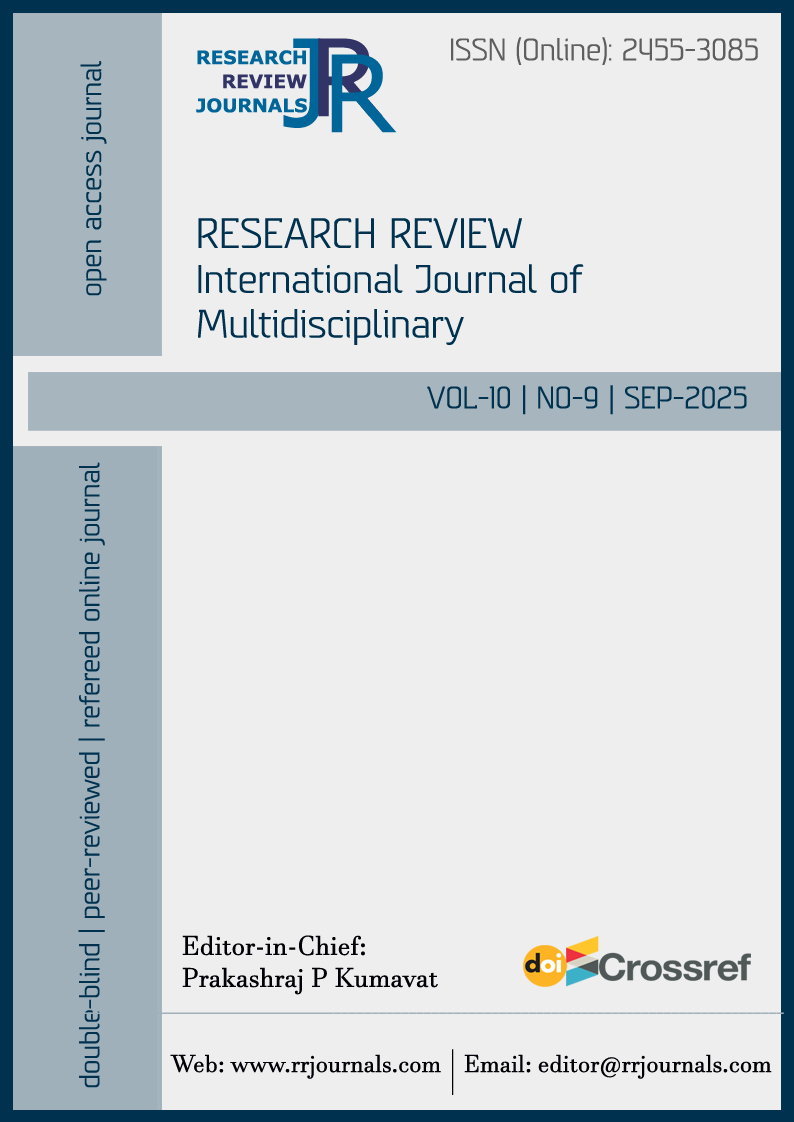Study on Vasicinone Production and Precursor Feeding from Callus Cultures of Justicia Adhatoda
DOI:
https://doi.org/10.31305/rrijm.2025.v10.n9.002Keywords:
MS medium, B5 medium, quinazoline alkaloid, Vasicinone, NMR, HPLC, precursorAbstract
The establishment of tissue culture methods for several medicinal plants made it possible to analyze callus/cell suspension extractions for the presence of several secondary products. Callus cultures were created in this work using Justicia adhatoda leaves and petioles. Earlier known as Adhatoda zeylanica Medicus on Murashige and Skoog (MS 1962) and Gamborg’s (B5 1976) medium. The extracts of the callus samples were compared with that of authentic Vasicinone by Co-TLC, and analyzed by 1HNMR, 13CNMR and Electron Ionization Mass Spectroscopy. Quantification of the vasicinone in different extracts of callus samples were done by HPLC analysis and their retention time in leaf-derived callus extract is 6.263 and for that of petiole-derived callus extract is 6.357 and both the samples are compared with that of Authentic vasicinone sample (6.2min retention time). Further the productivity of cell lines producing vasicinone was determined by adding different carbon sources viz., Glucose, Fructose, Sucrose, Mannose and aromatic amino acids Phenylalanine, Tyrosine, Ornithine as precursors to the culture medium and tested.
Metrics
References
Murashige, T.; Skoog, F. A Revised Medium for Rapid Growth and Bioassays with Tobacco Tissue Cultures. Physiol. Plant. 1962, 15, 473-497.
Gamborg, O. L.; Murashige, T.; Thorpe, T. A.; Vasil, I. K. Plant Tissue Media. In Vitro Plant 1976, 12, 473-478.
Farooqi, A. A.; Sreeramu, B. S. Introduction. In Cultivation of Medicinal and Aromatic Crops; Universities Press: Hyderabad, A.P., India, 2001; pp 1-7.
Bhattacharjee, S. K. In Handbook of Medicinal Plants (III); Pointer Publishers: Jaipur, India, 2001; pp 1-6
Merillon, J. M.; Ramawat, K. G. Introduction: Research Need. In Biotechnology Secondary Metabolites; Ramawat, K. G., Merillon, J. M., Eds.; Oxford & IBH Publishing Co.: New Delhi, 1999; pp 1-10.
Buckingham, J. Natural Products as Sources of New Drugs. In Dictionary of Natural Products; Chapman & Hall: London, 1994; Vol. 11, pp 125-160.
Mendelsohn, R.; Balick, M. The Value of Undiscovered Pharmaceuticals in Tropical Forests. Econ. Bot. 1995, 49, 223-228.
Hossain, M. T.; Hoq, M. O. Therapeutic Use of Adhatoda vasica. Asian J. Med. Biol. Res. 2016, 2(2), 156-163. https://doi.org/10.3329/ajmbr.v2i2.29005.
Ghosh, T. P.; Sen, J. N. Vasicine—An Alkaloid Present in Adhatoda vasica Nees. Q. J. Ind. Chem. Soc. 1925, 1, 315-320.
Jayapaul, K.; Kishor, P. B. K.; Reddy, K. J. Production of Pyrroloquinazoline Alkaloid from Leaf and Petiole-Derived Callus Cultures of Adhatoda zeylanica. In Vitro Cell. Dev. Biol. 2005, 41, 682-685.
Jayapaul, K.; Janardhan Reddy, K.; Sreelaxmi, L. Enhanced Production of Vasicine, an Alkaloid in Callus and Suspension Cultures of Adhatoda zeylanica. Plant Cell Biotechnol. Mol. Biol. 2022, 23(19&20), 11-22. ISSN: 0972-2025.
Babu, K. N.; Ravindran, P. N.; Peter, K. V. Spices. In Biotechnology of Horticultural Crops; Parthasarthy, V. A., Bose, T. K., Das, P., Eds.; Naya Prakash: Calcutta, India, 2001; Vol. 3, pp 329.
Atish, G.; Dhwani, D.; Kannan, S.; Lipasa, P.; Rani, R. Adhatoda vasica Attenuates Inflammatory and Hypoxic Responses in Preclinical Mouse Models: Potential for Repurposing in COVID-19-Like Conditions. Respir. Res. 2021, 22, 99.
Dey, T.; Dutta, P.; Manna, P.; Kalita, J.; Deka, H. P.; Unni, B. Anti-Proliferative Activities of Vasicinone on Lung Carcinoma Cells Mediated via Activation of Both Mitochondria-Dependent and Independent Pathways. Biomol. Ther. 2018, 26(4), 409-416. https://doi.org/10.4062/biomolther.2017.097.
Saxena, O. P.; Kumar, M.; Nandtirth, A.; Saxena, S. Identification of Bioactive Compounds from Medicinally Important Plants Grown In Vitro. In Plant Biotechnology: Recent Advances; Trivedi, P. C., Ed.; Panima Publishing Corp.: New Delhi, 1997; pp 380-388.
Sharma, A.; Lal, K.; Panda, S. S. Herbal Drug Standardization: HPLC Determination of Vasicine in Polyherbal Formulations. Int. J. Pharmacol. 1992, 30, 205-208.
Narayanaswamy, S. Regeneration of Plants from Tissue Cultures. In Applied and Fundamental Aspects of Plant Cell Tissue and Organ Culture; Reinert, J., Baja, Y. P. S., Eds.; Springer-Verlag: Heidelberg-New York, 1977; pp 178-248.
Fowler, M. W. Process Strategies for Plant Cell Cultures. Trends Biotechnol. 1986, 4, 214-219.
Avula, B.; Begum, S.; Ahmed, S.; Choudhry, M. I.; Khan, I. A. Quantitative Determination of Vasicine and Vasicinone in Adhatoda vasica by High Performance Capillary Electrophoresis. Pharmazie 2008, 63, 20-22. https://doi.org/10.1691/ph.2008.7175.
Roja, G.; Vikrant, B. H.; Santosh Kumar, S.; Sharma, A. Accumulation of Vasicine and Vasicinone in Tissue Cultures of Adhatoda vasica and Evaluation of the Free Radical-Scavenging Activities of the Various Crude Extracts. Food Chem. 2010, 126(3), 1033-1038. https://doi.org/10.1016/j.foodchem.2010.11.115.
Rashmi, P. A.; John, R.; Mathew, L. Isolation and Characterization of Vasicine from In Vitro Cultures of Justicia adhatoda L. Int. J. Pharm. Bio. Sci. 2012, 3, B58-B64.
Sreelakshmi, L.; Kishor, P. B. K.; Reddy, K. J. Enhanced Production of Psoralen, a Furanocoumarin in Callus Cultures of Cullen corylifolium (L.) Medik. Plant Cell Biotechnol. Mol. Biol. 2007, 1&2, 27-32.
Downloads
Published
How to Cite
Issue
Section
License

This work is licensed under a Creative Commons Attribution-NonCommercial 4.0 International License.
This is an open access article under the CC BY-NC-ND license Creative Commons Attribution-Noncommercial 4.0 International (CC BY-NC 4.0).



